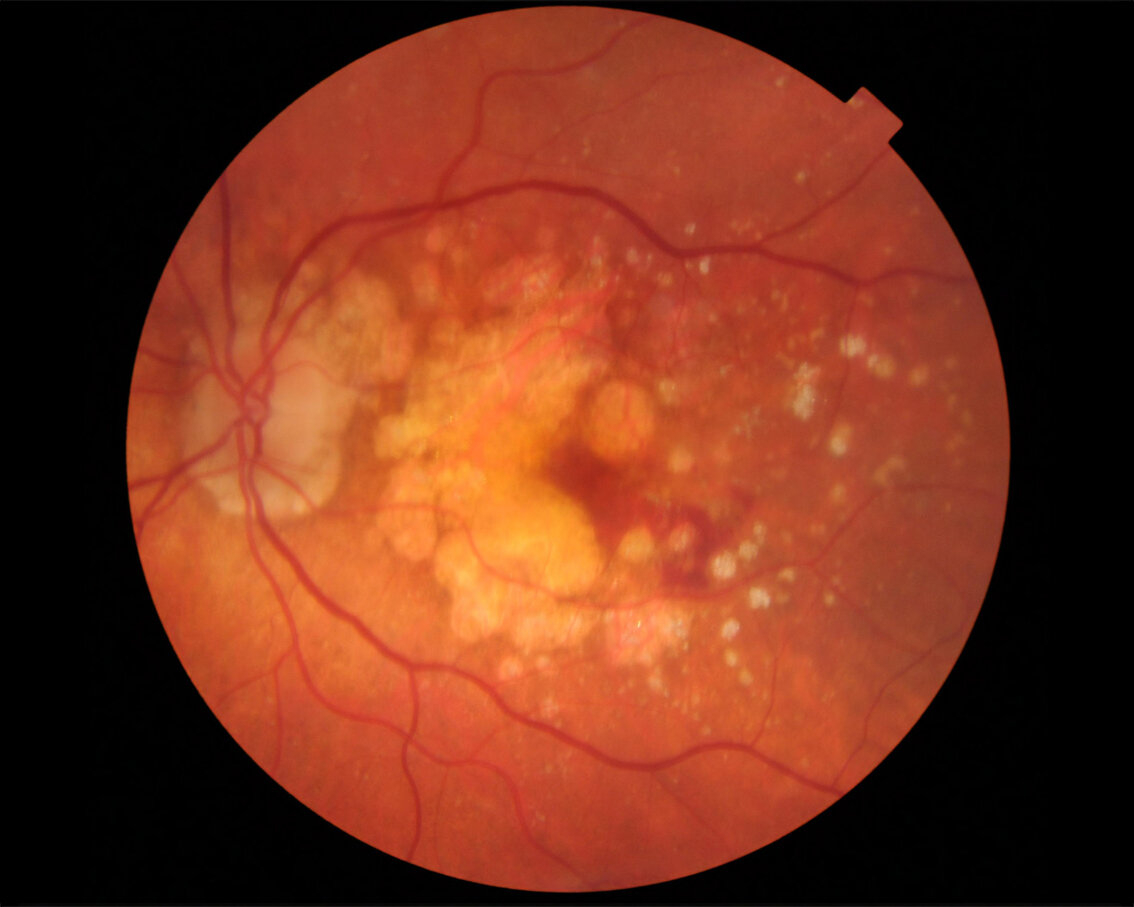Age-related Macular Degeneration (AMD)
This photo shows dry AMD, seen as the white patches in the centre of the orange retina. These white patches signify areas of wear and tear that do not work, causing gaps in the central vision.
What is Age-related Macular Degeneration?
Age-related macular degeneration (or AMD) is a condition that affects our retina as we get older. There are two types of AMD. In the dry type, wear and tear damage occurs in the macula, the area of the retina that we use reading and seeing fine detail in the distance. In a minority of people with dry AMD, the eye grows weak blood vessels that can bleed and leak. This is known as wet AMD.
What are the symptoms of age-related macular degeneration?
With the dry form, your central vision gradually becomes blurred and distorted. This may affect your ability to read and drive. In wet AMD, you may notice a sudden deterioration in this vision. In severe cases of both types, your ability to see faces or perform tasks requiring vision may be compromised. It is important to note that AMD only affects your central vision. Your peripheral vision should not be affected.
How do you treat age-related macular degeneration?
It is important to investigate your eyes to see if any treatment will be beneficial. This is usually done with retinal scans and sometimes using angiography, where a dye is injected into your arm and photographs of any abnormal blood vessels are taken. This allows me to accurately assess any damage present and demonstrate this to you.
These investigations may incur an additional cost from the Nuffield Hospital. I will not charge a separate fee for reporting on investigations as I believe that these are essential to a proper and comprehensive consultation.
Currently, there is no treatment for dry AMD. However, this remains a focus for research and there are numerous promising research trials aimed at finding new treatments.
You can slow down the wear and tear in your macula by eating a healthy diet, stopping smoking and wearing sunglasses with good ultraviolet light protection. Special vitamin supplements may help if you have certain types of AMD.
Wet AMD can be treated with a course of injections of drugs into the affected eye. These drugs stop the abnormal blood vessels from bleeding and leaking. This treatment is usually provided by the NHS on an outpatient basis. Occasionally, there can be severe bleeding inside the eye that requires surgery.
There are different lens implants that are designed to maximise how you use any remaining vision. In order to use them, cataract surgery needs to be performed first. Decision making about these lens is complex and depends on the technology available and extent of damage to vision. It is thought that few people will notice a significant benefit from these lenses.
What does the treatment involve?
Wet age-related macular degeneration is treated by injections into the eye, performed with local anaesthetic drops as an outpatient procedure. After the surface of your eye is numbed, a cleaning solution is used to disinfect the area. Your eyelids are gently held open and the drug is delivered through the white of the eye. The entire process lasts around 5 minutes. There is no special aftercare required.
Surgery for severe bleeding due to wet AMD is usually done as a day case under local anaesthesia. The length of the operation depends on the severity of damage present. It involves a procedure known as vitrectomy, where microscopic instruments are introduced through the white of the eye to remove the blood.
Where will I have treatment?
Injections and surgery are performed at Vision Care Clinic, Nuffield Health Bristol Hospital.

